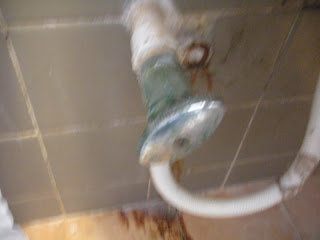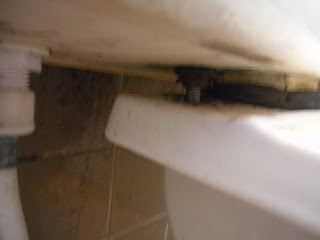Bob's Bloggers
A community of bloggers who live and die to DIY
plumbing, repair
The 140-Gallons-a-Day Toilet
By HomeCentrl on Mar 12, 2012
Recently I was asked to look into a water issue. The homeowners had received a water bill and not only was the charge extremely high but the amount of water shown to be used was also staggering. Now there are two people that live in this home and they both work and they assumed it had something to do with the toilet. Before I even went over I asked them to read their meter for a few days to see the actual amounts that were being used during their work absence. If they were using any amount while they were at work, something was leaking.
They agreed and were astounded. In their absence, 140 gallons a day was going somewhere. But first lets look at the toilet itself.
Once this happens the flapper falls back on the hole and water starts to refill the tank and when the water level raises the float to a set level the water is shut off.
How much water does a bad flapper waste?
Depending on the extent of the leak, a warped or poorly fitting flapper can waste up to 200 gallons of water a day and may cost you hundreds of dollars a year. http://www.toiletflapper.org/
The solution was:
1. Purchase and install a new supply line shut off.
2. Drain the tank and replace the bolts as well as install a new seal between the tank and bowl.
3. Install a new flapper.
This was not a major job and these three little changes, to this one toilet, will save 4200 gallons per month or over 50,000 gallons a year. That is a great deal of water and if you multiplied that by potentially thousands of homes, it really adds up. Don't put off fixing those "little" leaks it costs you and wastes water.
It was a coincidence but this week is :
They agreed and were astounded. In their absence, 140 gallons a day was going somewhere. But first lets look at the toilet itself.
You probably have a fair understanding of a toilet but the short easy version goes like this. When you flush the toilet the flapper that seals the water in the tank is released into the bowl and the "siphon effect" is created.
Once this happens the flapper falls back on the hole and water starts to refill the tank and when the water level raises the float to a set level the water is shut off.
My first step was to shut off the supply line and even when turned off the water still flowed into the tank. This isn't the problem but needs to also be fixed. More than likely the inner mechanism is corroded.
I next wiggled the entire toilet and it rocked a bit side to side on the floor. That meant that the bolts that attach the toilet to the floor were loose and needed to be tightened. Done.
I then turned my attention to the tank as it was also very loose and should be secure. Now the tank has 2 bolts that hold it to the toilet with a rubber seal between the two units. You can see this from the photo below and as you'll also notice the bolts are rusted and I wasn't able to tighten them.
I then turned my attention to the tank as it was also very loose and should be secure. Now the tank has 2 bolts that hold it to the toilet with a rubber seal between the two units. You can see this from the photo below and as you'll also notice the bolts are rusted and I wasn't able to tighten them.
The added issue here is that the tank is not properly seated to the toilet bowl and is on an angle. Without being able to tighten the bolts, I moved on to the flapper which I assumed from the beginning was the culprit.
The flapper in this case was old and needed to be replaced but because of the angle of the tank, it could seat properly and was allowing water to seep through constantly.
Depending on the extent of the leak, a warped or poorly fitting flapper can waste up to 200 gallons of water a day and may cost you hundreds of dollars a year. http://www.toiletflapper.org/
The solution was:
1. Purchase and install a new supply line shut off.
2. Drain the tank and replace the bolts as well as install a new seal between the tank and bowl.
3. Install a new flapper.
This was not a major job and these three little changes, to this one toilet, will save 4200 gallons per month or over 50,000 gallons a year. That is a great deal of water and if you multiplied that by potentially thousands of homes, it really adds up. Don't put off fixing those "little" leaks it costs you and wastes water.
It was a coincidence but this week is :



